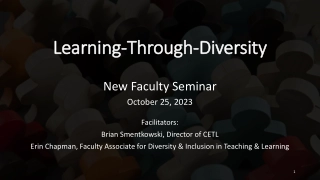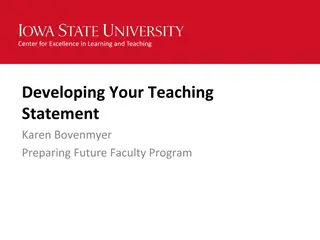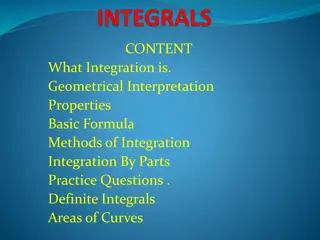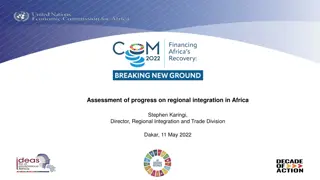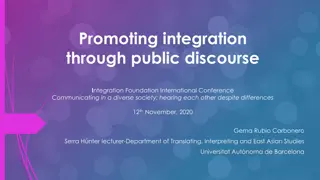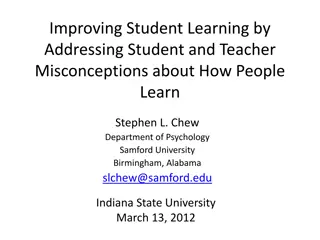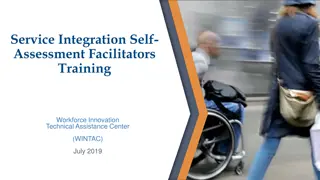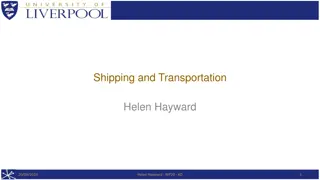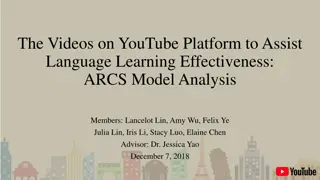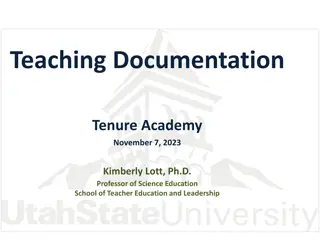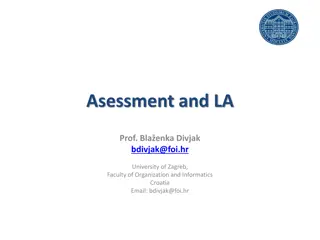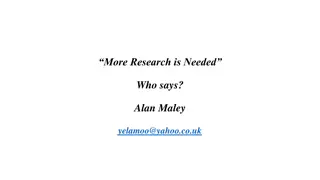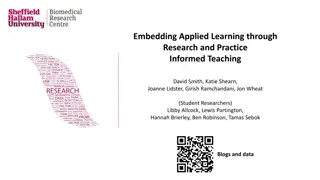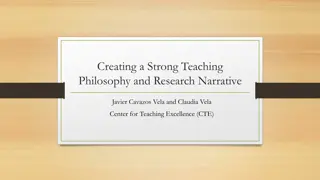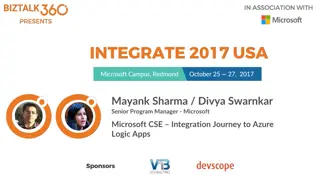Center for the Integration of Research, Teaching, and Learning (CIRTL)
CIRTL, founded in 2003, aims to develop a national STEM faculty committed to effective teaching practices for diverse student audiences. By leveraging graduate education, CIRTL seeks to enhance STEM literacy, increase diversity in STEM fields, and improve learning outcomes across academic disciplines. Through initiatives like Teaching-as-Research and Learning Communities, CIRTL fosters collaboration and innovation in higher education.
Download Presentation

Please find below an Image/Link to download the presentation.
The content on the website is provided AS IS for your information and personal use only. It may not be sold, licensed, or shared on other websites without obtaining consent from the author. Download presentation by click this link. If you encounter any issues during the download, it is possible that the publisher has removed the file from their server.
E N D
Presentation Transcript
CIRTL IS The Center for the Integration of Research, Teaching, and The Center for the Integration of Research, Teaching, and Learning. Learning. CIRTL was founded in 2003 as a National Science Foundation Center for Learning and Teaching in higher education. National Science Foundation CIRTL uses graduate education as the leverage point to develop a national STEM faculty committed to implementing and advancing effective teaching practices for diverse student audiences as part of successful professional careers. The goal of CIRTL is to improve the learning of all students at every college and university, and thereby to increase the diversity in STEM fields and the STEM literacy of the nation. Importantly, CIRTL is now more than STEM: it includes and applies to all academic disciplines.
Spatially and Institutionally, We Are This year, Brown University will become a member institution, with UI-CETL as it s mentor
Learning Learning- -through through- -Diversity Diversity Learning-through-diversity capitalizes on the rich array of experiences, backgrounds, and skills among undergraduates and graduate-through-faculty to enhance the learning of all. It recognizes that excellence and diversity are necessarily intertwined. Core Ideas Teaching Teaching- -as as- -Research Research Teaching-as-research is the deliberate, systematic, and reflective use of research methods by instructors to develop and implement teaching practices that advance the learning experiences and outcomes of both students and teachers. It is curiosity and reflection-driven. Learning Communities Learning Communities Learning communities bring together groups of people for shared learning, discovery, and generation of knowledge. To achieve common learning goals, a learning community nurtures functional relationship among its members.
Developed By and Leveraged Through Cross-Network Programming Through Network-sponsored programs and member institution programming, graduate students and post-docs have access to expert-led workshops, courses, resources, and materials. All Teaching-as-Research and integrated Learning- through-Diversity<->Teaching-as-Research and SoTL initiatives are led by the University of Idaho. Talk to Brian to learn more! All graduate students and post-docs have an opportunity to participate in and present at annual CIRTL Conferences.
Value Proposition and Opportunities As part of the CIRTL Network, University of Idaho graduate students and post docs achieve a differentiating experience that not only provides a competitive advantage in the job market, but positions them as powerful agents of change in STEM education on and beyond our campus. It enters our students and post docs into a community of future faculty and scientists who learn from the leading scholars at leading research institutions, of which we are one. In short, CIRTL helps prepare tomorrow s leaders today. CIRTL advances success through tiered Learning Outcomes (Levels) for CIRTL- affiliated graduate students and post docs. This is realized through a combination of CIRTL- sponsored- and institutionally-designed programs.
CIRTL at the University of Idaho Programming Supporting, Offered Through, and Relating to CIRTL is Coordinated through the Center for Excellence in Teaching and Learning. Brian Smentkowski leads Teaching as Research, Learning through Diversity, and other CIRTL initiatives for the Network and UI.
A Collaborative and Evidence-Based Approach to Preparing Future Faculty: CETL s PFF Program
UI CIRTL Levels, Opportunities, and Credentials 1 2 3 Associate Level: Understanding and implementing evidence-based pedagogy. Practitioner Level: Engage in Teaching As Research Scholar Level: Share Your Research Graduate students/post-docs transform their projects into a presentable or potentially publishable manuscript Manuscript submitted for presentation or publication CIRTL Scholar Certificate earned and eligibility for professional development (travel) funding. Participate in 6+ pedagogy PFF/CIRTL workshops Understand the foundations of evidence-based teaching and learning; integrated research, teaching, and learning; Teaching as Research; and Learning Through Diversity 1:1 Teaching and Learning mentorship CIRTL Certificate issued to all participants For participants interested in TAR, a CIRTL Associate-Level Teaching as Research Certificate. For participants interested in DEIA, a CIRTL Learning through Diversity Certificate. Participate in a TAR Cohort Meets twice in the Fall and twice in the Spring Purpose: develop a curiosity/hypothesis driven question/approach to teaching and its impact on learning and engage in reflective teaching practice Grad students/post-docs create a TAR Proposal, implement a TAR Project, and submit an experiential reflection. Participants can participate in CIRTL Cross-Network Programming, earn a CIRLT TAR Practitioner Certificate, and be eligible for funding and support to present their work at CIRTL events.
Preparing Future Faculty (PFF) Programming and Certificates Higher Education Pedagogy UI-CIRTL Certificates Learning-through-Diversity (LTD) CIRTL Certificate 7 IN-PERSON SESSIONS Teaching-as-Research (TAR) CIRTL Certificate 3 75-minute ZOOM Sessions The Professoriate & Professions 8 of 9 50-minute Zoom Sessions Faculty Development Certificate Approaching the Market Mentoring-Based Support Basic Certificate Associate Level Online-Asynchronous Canvas Class Session 1: What it is, what it means, and why it matters. The value of DEIA in higher education September Session 1: What it is, why it matters, principles of reflective/scholarly teaching, thinking about causality and if-then teaching for learning OCT Understanding and Navigating the Changing Terrain of Higher Education SEPTEMBER Identifying and Pursuing Your Options Advanced Certificate Practitioner Level Online-Asynchronous Canvas Class Session 2: Integrating the CIRTL Framework. Diversity and higher education, teaching, and learning October Session 2: Developing a TAR question, expected results, strategies of inquiry, exposure to the literature NOV Understanding Different Institutional Types, Expectations, and Contexts OCTOBER Developing Your Dossier Self-paced Can be done in one semester or over the span of an academic year. Session 3: Inclusive and Equitable Teaching and Learning Strategies November The time between the sessions is for participants to develop a TAR question or an idea about how a teaching strategy or innovation can positively affect teaching and learning. Set-up for CIRTL TAR Summer Program, Practitioner Level, and potentially SoTL/Scholar Level Working Relationships, Collegiality, and Communication NOVEMBER Writing to Your Audience: External Mentor-Led Session Session 4: Universal Design for Learning and Accessibility JAN Session 3: Preparing and Submitting CIRTL TAR Summer Program App FEB Teaching, Scholarship, & Service: DECEMBER Developing and Refining an Authentic DEI Statement Session 5: Culturally Responsive Pedagogy FEB Balance, Boundaries, Well-Being, and Different Definitions of Success JAN Developing and Refining Your Teaching Philosophy Session 6: Indigenous Ways of Knowing MAR Designing A Productivity Pathway FEB Preparing For Interviews Session 7: Pulling it all Together: A Plan for Advancing Equitable Educational Experiences APRIL Mentoring: What to Look For/What to Expect MAR Interview Simulations DEI for Everyday Practice APRIL Teaching Observations Alternate Career Options
Basic and Advanced Certificates CIRTL Certificate in Higher Education Pedagogy/1st Year Cohort Introductory. Foundational. 6 of 9 required. Advanced CIRTL Certificate in Higher Education Pedagogy/Second Year Application-based. 3 of 7 required. Practitioner Level CIRTL LTD and TAR Certificates: Associate Level Practitioner Level Scholar Level Teaching for Learning: Strategies and Approaches/LTD Developing and refining an instructional presence See Associate, Practitioner, and Scholar levels of engagement slide. Integrating LTD & TAR Going Public with TAR. (TAR SoTL) Scholarly/Reflective Teaching Developing and refining inclusive teaching practices UDL: a framework for inclusion and accessibility Developing and refining a teaching philosophy Online teaching and learning Designing a Course Teaching and learning technologies Teaching Innovations and HIP Integration Outcomes and Assessment Fostering critical thinking, reflection, and metacognition Handling Hot Topics Application of technology High Impact Practices Self-Regulated Learning
Enhancing the Value Proposition While the primary audience includes graduate students and post docs It is the give-back to undergraduate education through their service as scholars and teachers that makes a difference on and beyond our campus; It is the network of international faculty that enriches the educational and professional experiences of participants through collaboration; It is a concerted effort to attract, educate, and place graduate students and post docs with reputable CIRTL credentials; It now extends beyond STEM disciplines in an effort to improve graduate and post doctoral experiences in all fields, and to improve graduate and undergraduate education generally; It is access to cutting edge and expert-led evidence-based resources; and A life-long and robust population of CIRTL faculty and alumni that provides support and sustains innovation in the union of research, teaching, and learning.
Notes: CIRTL Values Learner Learner- -Centered Education: Centered Education: Learning is shaped by the needs, identities, experiences, communities, and goals of our learners. We develop educators who place learners at the center of their work. Equity and Inclusion: Equity and Inclusion: In equitable and open environments, everyone is respected, valued, and encouraged, so that they are able to contribute to their fullest potential. We work to develop and sustain inclusive working spaces and learning communities that achieve equitable outcomes. Diversity and Representation Diversity and Representation: Diversity of people brings forth diversity of ideas and learning. We cultivate and engage participation as a network, including leadership, that is representative of the demographics and lived experiences of the broader population. Collaboration Collaboration: Working together allows us to better achieve our co- created goals. We engage constituencies at all levels within and across institutions as colleagues in our work. Inclusive Excellence and Innovation: Inclusive Excellence and Innovation: Critical examination of data, scholarly reflection, and collective review are our standards of excellence. We innovate for mutual improvement of inclusive educational practices. Intellectual Generosity: Intellectual Generosity: Mutual openness to ideas of each other advances understanding and discovery of knowledge. Acknowledging that there are multiple ways of knowing, we respectfully listen and share our ideas, perspectives, practices, and expertise. Reflective Decision Reflective Decision- -Making: landscape of the CIRTL Network. We gather, share and analyze evidence to make data-informed decisions to collectively guide the CIRTL Network. Making: Reflective decision-making is responsive to the evolving


